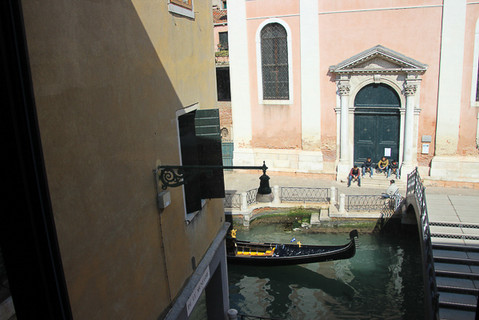A day with gondolas and gondoliers
- Venecisima Venecisima
- 22 dic 2020
- 5 Min. de lectura
Actualizado: 29 nov 2022
Navigating and rocking along the canals we discover some magical aquatic beings: THE GONDOLAS guided by other no less magical beings: THE GONDOLIERS

Follow this article while you listen to the song that in In 1830, the famous composer Meldenssohn performed in homage to the gondola (press the black button that indicates "Listen in browser" on mobile).
What you are going to discover in this article:
Curiosities of the gondolas, such as the gondolas-spa or the reason for its black colour
Tips for a gondola ride through the canals
An observatory of gondolas while having a glass of wine
Where gondolas are born
A master lesson to be a gondolier
The name “Gondola” derives from the combination of two words: the verb "Dondolare", swing and the word "cunula" cradle, since the first gondolas were smaller and shorter than the current ones, and are reminiscent of ancient cradles.
AN UNKNOWN USE: GONDOLAS AS A SPA

During the 18th century, with the discovery of marine thermalism and with the fashion of holidays on the coasts, it was established that baths in the waters of the Venetian lagoon had healing properties!.
And "the Sirens" were born, gondolas that were adapted for the ladies to bathe comfortably, away from prying eyes. These gondolas were designed by replacing the bottom with a grid and providing them with a felze (a covered cabin). Thus, the ladies enjoyed the whirlpool produced by the gondoliers rowing against the current in total privacy.
AND OTHER USES
The gondolas are also used and were used to bring brides to the altar on her wedding day, adorned with white flowers and with two gondoliers also dressed in white, and there are even websites specialized in weddings officiated in the gondolas!

And also as a journey to the afterlife, as they were used in the funeral procession. Watch the following video from the 40s:
Gondolas also participate in famous regattas such as the Historical Regatta.
A RIDE IN A GONDOLA
HOW MUCH DOES IT COST?
See official rate. In 2020, € 80 for 40 minutes (be careful! The price is per gondola and not per person). And € 100 at night. You can share the gondola, talking with other tourists to make it cheaper.
HOW TO CONTRACT THE WALK?
There are specific points, like the Stazio Bauer that I mark you on the map at the end.
Here are the places where you can go directly for a gondola ride (also on the map in the layer "Muelles paseo en góndola")
San Tomà Station : in San Tomà along the Grand Canal.
Muelle dell'Accademia : in front of the Galleria de la Academia.
Santa María del Giglio station: near the Santa María del Giglio church
Bacino Orseolo station in San Marcos: a few meters from Piazza San Marco towards Rialto.
Danieli Station: in front of the Hotel Danieli
Vallaresso Station, next to the Royal Gardens

Or when you go strolling through streets and canals you will find small moorings where there are usually one or two gondolas and gondoliers will ask you "gondola?", You still have to haggle to get the official price. With them, the walks are usually through small channels and less known areas.

And there are also specialized websites where you can book in advance, and that offer you many variants, including taking cicchettis (tapas) in the gondola itself or with a serenade.
WHAT TOUR?
There are tours in small canals or to the Grand Canal. I particularly like those that take you through narrow and little-traveled canals, but if it's the first time, the departure from Bauer station to the Grand Canal is beautiful, with a tour of the canals near Teatro La Fenice.
And more examples of tours.
"LOW COST" GONDOLA

The low-cost gondola ride is the Traghetto, a similar vessel that simply crosses the Grand Canal from one shore to the other for 2 euros, lasts a few minutes and you usually go on foot.
In This post will explain where and how to go up to the Traghetto (also on the map in the "Traguetto" layer)
MORE EXPERIENCES WITH GONDOLAS AND GONDOLIERS ("Otros lugares del paseo" layer of the map)
1. WATCHING THE GONDOLAS PASSING
I love to watch them pass by the San Luca river, in front the old church of San Luca. There is a small wine bar (on the left hand side facing the entrance of the Simply supermarket) with a balcony.
2. GASTRONOMIC EXPERIENCE NEXT TO GONDOLIERS
And below the wine bar, the TEN restaurant, where you will find many gondoliers sitting at their tables (and the salads are delicious)
3. SQUERO SAN TROVASO: GONDOLAS ARE BORN HERE
The place where Venetian artisans hand made its famous gondolas is called Squero. Squero San Trovaso, offers guided tours, although for groups of at least 25 people and by booking in advance at info@squerosantrovaso.com.

4. ARZANÀ MUSEUM: THE LIFE OF THE GONDOLAS
It is a museum that traces the history and evolution of the gondola. You can see one of the few covers that were mounted in the center of the gondolas, called «felze«, or an old "fresco gondolín", a type of gondola that was used for summer rides. Here you can request a visit.
5. AND ... CAN I TRY TO DRIVE A GONDOLA?
No. It is prohibited for an unlicensed person to drive a gondola. For those interested, there is an organization that offers gondola navigation lessons (Rowvenice.org), although it is done in a similar boat, the batellina.
Learning to row a gondola
WHY DID GONDOLAS RISE IN VENICE IN THE CANALS?
Venice, since its birth, has been made up of islands and many channels between them, some too narrow for large boats. Thus was born this new being in Venetian life, for the transport of goods in shallow areas (hence its flat bottom) and narrow
There was no inventor or designer: the elegant ship that rocks the Venetian canals was developed through the centuries as you can see in the following pictures






The first documentary reference to the gondola is from the 11th century (in 1094, the Dogo Vito Faliero signed a certificate for its construction) although some experts speak of its origin in the 7th century.
WHAT IS THE GONDOLA'S FERRO?

The gondola ferro actually is a miniature map of the city with its six neighborhoods, the S shape of the Grand Canal and lately some decorations have been added inserted between tooth and tooth of the comb representing the islands of Murano, Burano and Torcello
WHY ARE GONDOLAS BLACK?
A historical moment arrived in which the Venetian nobility and bourgeoisie used the gondolas as a symbol of wealth and power. So every time they added more ornamental and luxury elements that embellished the boats, competing with each other.

Finally, the Government of the Republic of Venice, opted for the prohibition and for the homogenization of the gondolas, which had to be painted black.
When I grow up, I want to be a gondolier! (or gondolier)
The profession of "gondolier" was born when the Venetian aristocrats acquired the habit of moving in private gondolas, with their own fixed and salaried gondolier.
Evolution of gondolier clothing
Until the 1980s, the trade was transmitted exclusively from father to son, forming a kind of "caste". Nowadays, you have to pass selection tests quite exhaustiveto be a gondolier. And there is only one gondolier woman!
Gondolas are a relic of the past that has traveled swaying through time to this day. They are the first image that comes to mind of the city, A WORK OF ART IN MOTION.


















Comentarios